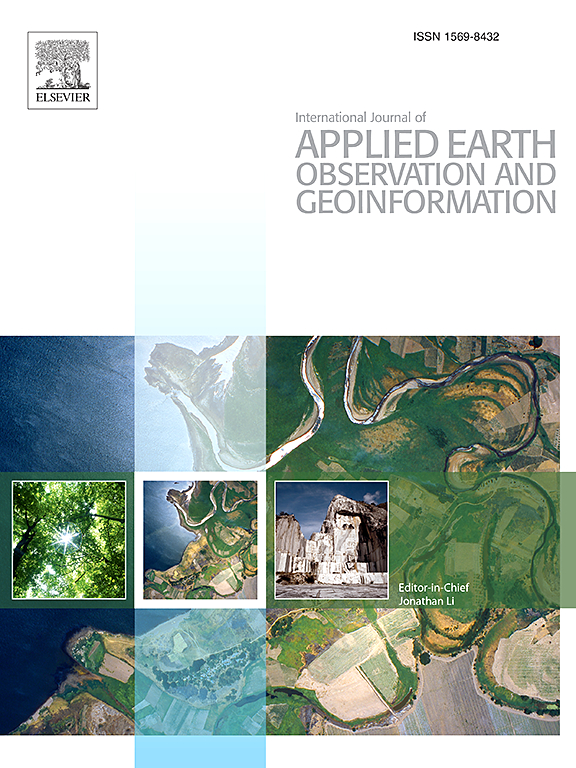PyramidMamba: Rethinking pyramid feature fusion with selective space state model for semantic segmentation of remote sensing imagery
IF 7.5
1区 地球科学
Q1 Earth and Planetary Sciences
International Journal of Applied Earth Observation and Geoinformation
Pub Date : 2025-10-04
DOI:10.1016/j.jag.2025.104884
引用次数: 0
Abstract
Semantic segmentation, as a basic tool for remote sensing image understanding, plays a vital role in many Earth Observation (EO) applications. Nowadays, accurate semantic segmentation of remote sensing images remains a challenge due to the complex spatial–temporal scenes and multi-scale geo-objects. Driven by the wave of deep learning (DL), CNN– and Transformer-based semantic segmentation methods have been explored widely, and these two architectures both revealed the importance of multi-scale feature representation for strengthening semantic information of geo-objects. However, multi-scale feature fusion often comes with the semantic redundancy issue due to homogeneous semantic contents in pyramid features. To handle this issue, we propose a novel Mamba-based segmentation network, namely PyramidMamba. Specifically, we design a plug-and-play Mamba-based decoder, which develops a dense spatial pyramid pooling (DSPP) to encode rich multi-scale semantic features and a pyramid fusion Mamba (PFM) to reduce semantic redundancy in feature fusion. Ablation experiments illustrate the effectiveness and superiority of the proposed method in enhancing multi-scale feature representation as well as the great potential for real-time semantic segmentation. Moreover, our PyramidMamba yields state-of-the-art performance on four public datasets, i.e. the OpenEarthMap (70.8% mIoU), ISPRS Vaihingen (84.8% mIoU) and Potsdam (88.0% mIoU) datasets, and the LoveDA (54.8% mIoU) dataset.金字塔曼巴:基于选择性空间状态模型的金字塔特征融合遥感图像语义分割
语义分割作为遥感图像理解的基本工具,在许多对地观测应用中起着至关重要的作用。当前,由于遥感图像的时空场景复杂,地物多尺度,对遥感图像进行准确的语义分割是一个挑战。在深度学习(deep learning, DL)浪潮的推动下,基于CNN和transformer的语义分割方法得到了广泛的探索,这两种架构都揭示了多尺度特征表示对于增强地理目标语义信息的重要性。然而,由于金字塔特征的语义内容同质,多尺度特征融合往往存在语义冗余问题。为了解决这个问题,我们提出了一种新的基于mamba的分割网络,即PyramidMamba。具体来说,我们设计了一个即插即用的基于曼巴的解码器,该解码器开发了密集空间金字塔池(DSPP)来编码丰富的多尺度语义特征,并开发了金字塔融合曼巴(PFM)来减少特征融合中的语义冗余。烧蚀实验证明了该方法在增强多尺度特征表示方面的有效性和优越性,以及在实时语义分割方面的巨大潜力。此外,我们的PyramidMamba在四个公共数据集上产生了最先进的性能,即OpenEarthMap (70.8% mIoU), ISPRS Vaihingen (84.8% mIoU)和Potsdam (88.0% mIoU)数据集,以及LoveDA (54.8% mIoU)数据集。
本文章由计算机程序翻译,如有差异,请以英文原文为准。
求助全文
约1分钟内获得全文
求助全文
来源期刊
CiteScore
10.20
自引率
8.00%
发文量
49
审稿时长
7.2 months
期刊介绍:
The International Journal of Applied Earth Observation and Geoinformation publishes original papers that utilize earth observation data for natural resource and environmental inventory and management. These data primarily originate from remote sensing platforms, including satellites and aircraft, supplemented by surface and subsurface measurements. Addressing natural resources such as forests, agricultural land, soils, and water, as well as environmental concerns like biodiversity, land degradation, and hazards, the journal explores conceptual and data-driven approaches. It covers geoinformation themes like capturing, databasing, visualization, interpretation, data quality, and spatial uncertainty.

 求助内容:
求助内容: 应助结果提醒方式:
应助结果提醒方式:


